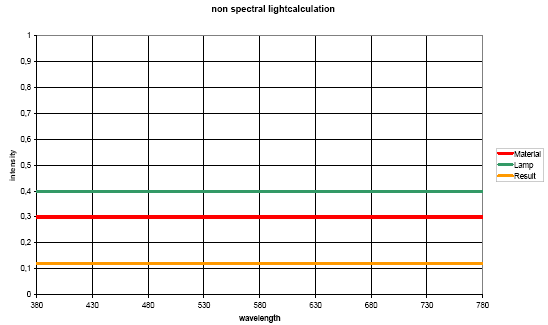- Главная
-
Учебник
- DIALux 4
- DIALux evo
- IES
- Форум
- Галерея
- Блоги
-
Скачать
- DIALux
- Базы
- Плагины
- 3D модели
- Текстуры
- Книги
-
Новости
Background information
20 августа 2012 - АдминUp to now DIALux only calculated “white” light. The amount of “light energy” distributed by the luminaire was defined by the luminous flux of the lamp(s) and the light output ratio of the luminaire. The spectral distribution, the wavelengths of the distributed radiation was not taken into account. This approach is usually correct, because interior and exterior lighting design is mainly made with “white” light sources. Calculated values are totally correct, as long as only direct light is taken into account (without reflection). When reflected light has to be considered, the mistake made in the calculation can be serious. This depends on the spectral reflection of the material and the spectral distribution of the light sources.
Technical data of luminaires mainly describe the distribution of the light. Well known examples are the DIALux internal ULD format, CIBSE TM14, EULUMDAT, IES and others. The data describes the intensity of light from the light centre of the luminaire in defined directions. Unfortunately there is no information about the spectral distribution of the light from the light source given. Typically text informs the user which lamp is used e.g. T5 / 49W 830. The expert knows, that this is a triphosphor fluorescent lamp with a correlated colour temperature of 3000K and a colour rendering index greater than 80. The colour of light is now more or less described but not for a correct calculation. If light is to be calculated correctly including the colour information, it is absolutely necessary to know the spectral distribution.

Fig. 174 Spectral light calculation
In this diagram you can see the spectral distribution of the light source (green) and the spectral reflection factor of a material (red) in the visible spectrum. The reflected light from this surface would have the spectral distribution as shown by the orange line. Up to now, this effect was not taken into account by the calculation. For the light source the radiation was constant over the visible spectrum. The amount was defined by the luminous flux. For the material also the reflection factor was taken as constant over the visible spectrum.

Fig. 175 Non spectral light calculation
That this effect leads to serious errors calculating coloured light or coloured material is obvious.
DIALux can now take into account the spectra of light sources, the spectra of colour filters and materials. The luminous flux of the lamp is now distributed to the individual wavelengths according to the data given in the spectral distribution. Because of this the results are more accurate and the visualisation is improved. Now all colour effects can be displayed in the rendering.Рейтинг: 0 Голосов: 0 3284 просмотраКомментарии (0)Manual
